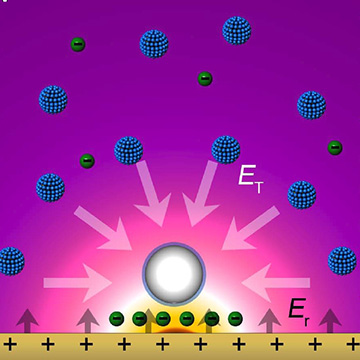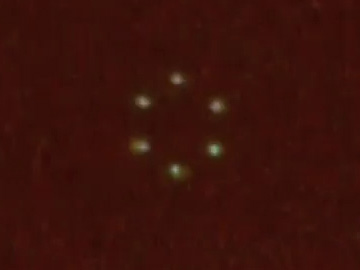
The opto-thermoelectric nanotweezers (OTENT) technique uses a thermally generated electric field in a suspension of positive and negative ions to trap metallic nanoparticles. [Image: Courtesy of Linhan Lin]
Optical tweezers, which trap tiny particles using gradient forces near a highly focused laser beam, have a long pedigree in biological and physical studies. But for nanoparticles that absorb optical energy, such as metallic particles, the high laser powers required with conventional optical tweezers can potentially damage the very particle one is trying to study.
Now, a team led by Yuebing Zheng of the University of Texas, Austin (USA), has found a novel way to trap such particles at much lower power levels (Nat. Photon., doi: 10.1038/s41566-018-0134-3). Rather than capturing the particle directly via the laser field’s gradient forces, the team’s technique uses the laser indirectly, to create a thermally induced electric field in an ion solution that muscles the nanoparticle of interest into place and holds it there.
The researchers say the method—which they call opto-thermoelectric nanotweezers (OTENT)—lowers the required laser power by two to three orders of magnitude, and is sufficiently general to trap not only metallic nanoparticles but also semiconductor, polymer and dielectric materials. The OTENT technique, they conclude, could thus offer a new platform for the study of cell-cell interactions, nanoparticle drug delivery and metamaterials.
Enlisting thermophoresis
Conventional optical tweezers have a number of disadvantages in trapping metallic nanoparticles. One is that enhanced absorption and scattering of laser energy by the nanoparticle itself can reduce the “stiffness,” or holding power, of the optical trap. And heating of subwavelength metallic nanoparticles by the high-power lasers required to trap them can compromise the experiment and even damage the particle itself.
The UT Austin-led researchers sought a way to go a bit easier on the nanoparticle by reducing the laser power needed to trap it. And they found a possible answer through a well-known property from chemical physics: thermophoresis.
Under thermophoresis, small ions in mixtures or solutions that are subject to a temperature gradient tend to diffuse, at different rates, from relatively hot to relatively cold regions in the mixture. Some ions, because of differences in their molecular masses and their diffusivity characteristics (parametrized in a number called the Soret coefficient), move faster into the cold zones than other ions do. That, in turn, can set up a thermally driven electric field in the solution, proportional to the size of the temperature gradient.
The UT Austin team thus reasoned that a laser might be used not to trap a metallic nanoparticle directly, but instead as a heat source to set up a temperature gradient in an ionic solution containing the particle. The resulting thermophoresis-induced electric field, rather than focused laser energy, would then push the particle into place. Such a system, they reckoned, could allow for a trapping platform requiring much lower laser power—on the order of hundreds of microwatts rather than hundreds of milliwatts.
Trapping nanospheres
To test out the OTENT system, the team began by using thermal evaporation and annealing to lay down porous, nubby gold films of a few nanometers thickness onto glass slides. These gold substrates were then placed beneath colloidal suspensions containing dissolved metallic nanostructures, such as 100-nm gold or silver spheres.
The team then added a chemical surfactant, cetyltrimethylammonium chloride (CTAC), to the mix. Some of that surfactant wrapped around the individual metal nanospheres to create a positively charged layer around the particles. The rest of the CTAC molecules clumped into positively charged aggregates or “micelles” and negatively charged chlorine ions, distributed evenly throughout the suspension.
Next, the researchers focused a 532-nm laser beam, at an optical power of around 200 μW and a two-micron beam diameter, onto the gold substrate. Subwavelength plasmonic heating on the substrate created a local hotspot that produced a thermal gradient in the solution. This caused the positive CTAC micelles—which have a relatively higher Soret coefficient—to move away from the hotspot, and to the colder regions of the suspension, faster than the chlorine ions.

Before laser heating (left), positive and negative ions are evenly distributed. Laser heating causes differential migration of ions in the suspension (middle), creating electric field that traps the positively charged nanoparticle (right). [Image: Courtesy of Linhan Lin]
“Both the positive and negative ions will move from the hotspot to the cold region,” said co-lead author Linhan Lin of U.T. Austin. “But the good thing is that the positive ones will move there faster, so the electric field will point to the laser spot.” That, in turn, moves the positively charged nanoparticle back toward the hotspot, where an electrostatic balance between the electric field and the gold substrate held the particle in place (see diagram).
The team used this low-power setup not just to trap metallic nanospheres but also to trap and manipulate metallic nanowires and to capture and hold nanoparticles made of silicon, silica and polystyrene. The researchers were also able to use in situ dark-field spectroscopy on the trapped particles, establishing the setup’s potential as a platform for study and analysis of the nanoparticles. And, using a digital micromirror device, the team divided the laser into six beams to create six separate hotspots, trapping six silver nanospheres at once in a circular pattern.
Cell-cell interactions

Using the OTENT setup with a digital micromirror device, the team was able to trap six silver nanospheres in a circular pattern. [Image: Cockrell School of Engineering, UT Austin]
The researchers believe that the combination of low power, simple optics, and generality in the type of particles opens up an interesting application space for the OTENT technique. Zheng notes, for example, that using conventional, higher-power optical tweezers to trap and manipulate biological cells generally limits the experiment to a very short duration. “With this method,” he says, “we can do a longer-time study, and we can directly trap and manipulate molecules.”
This, he suggests, could allow experiments in which “we can directly grab cells and bring them together,” to study cell-cell interactions and communications among such cells as neurons and immune cells that might be damaged by conventional optical tweezers. And the combination of low-power trapping and in situ spectroscopy could also prove useful in manipulating combinations of nanoparticles and cells, to test the efficacy of nanoparticles for drug delivery.
In addition to scientists from UT Austin, researchers from Penn State University and the University of California, Los Angeles (USA), CIC biomaGUNE (Spain), and the Middle East Technical University (Turkey) also participated in the work.
